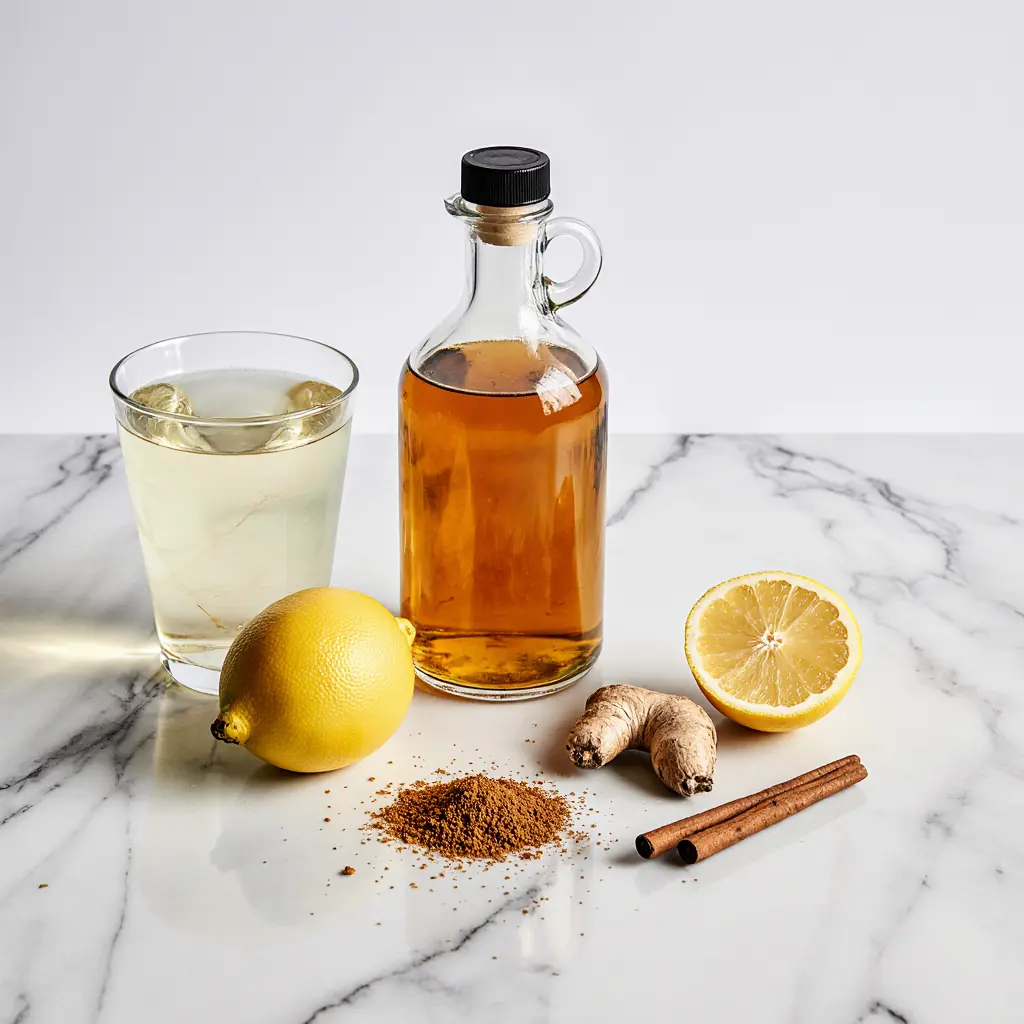Looking for a powerful yet simple Vinegar Tonic DIY to start your mornings right? This warming blend of apple cider vinegar, lemon, cinnamon, and ginger has become a go-to wellness ritual for many—especially for those trying to manage cravings, digestion, and blood sugar without relying on packaged supplements.
The Vinegar Tonic DIY movement has grown quickly, thanks to its ease, affordability, and all-natural ingredients that you likely already have at home. While some compare it to more intensive tools like GLP‑1 medications, this tonic acts more gently and works best as a consistent daily support. In this article, you’ll learn how to make it, how to use it properly, and what science (and safety) says about it.
Let’s start by understanding what makes each ingredient in this Vinegar Tonic DIY effective—and where the hype may go too far.
Ingredients and Their Claimed Benefits
Apple Cider Vinegar: Acetic Acid & Blood Sugar
Apple cider vinegar (ACV) is the heart of any good Vinegar Tonic DIY recipe. It contains acetic acid, which research suggests may help regulate blood sugar levels and delay stomach emptying. That’s why many people use it before meals or first thing in the morning—it may help you feel more balanced and less prone to sugar cravings.

Lemon: Digestion and Alkalinity Claims
Lemon adds brightness and vitamin C, and it’s said to support digestion. While your body regulates pH levels on its own, lemon’s metabolites are considered alkaline-forming. In the context of a Vinegar Tonic DIY, lemon also softens the sharpness of vinegar, making it easier to drink regularly.
Cinnamon: Insulin Sensitivity
Ceylon cinnamon gives this tonic both a cozy flavor and potential blood sugar support. Several studies suggest it may help improve insulin sensitivity when used consistently. It’s a smart addition to any Vinegar Tonic DIY aiming to support metabolism naturally.
Ginger: Thermogenesis and Craving Reduction
Ginger brings warmth and a bit of a kick. It may promote thermogenesis—your body’s ability to burn calories—and can also reduce nausea and support gut comfort. In this Vinegar Tonic DIY, it helps round out the sharp notes while offering its own digestive benefits.
How to Make the Morning Tonic
Best Ratios and Temperature
A balanced vinegar & spice tonic doesn’t need to be complicated. The key is using enough active ingredients without overloading the system—or your taste buds.

Here’s a basic starting formula for one serving:
| Ingredient | Amount |
|---|---|
| Apple Cider Vinegar (raw, with the mother) | 1 tablespoon |
| Fresh Lemon Juice | 1 tablespoon |
| Ceylon Cinnamon (ground) | ¼ teaspoon |
| Fresh Grated Ginger (or ¼ tsp powdered) | 1 teaspoon |
| Warm Water (not boiling) | 8–10 oz |
Mix thoroughly in a glass or shaker. Use warm—not hot—water to protect the nutrients and enzymes in the vinegar and lemon.
Ideal Timing (Morning Fasted)
Drink this tonic first thing in the morning, about 15 to 30 minutes before eating. This timing is often considered the most effective window for reducing cravings, stimulating digestion, and supporting blood sugar response for your first meal of the day.
Make sure to wait a few minutes before brushing your teeth, since the acidity can temporarily soften enamel.
Flavor Tweaks and Safety Notes
If the flavor feels too strong at first, try these simple adjustments:
- Add a teaspoon of raw honey for a touch of sweetness
- Swap ginger powder for fresh grated ginger if texture is an issue
- Use a reusable straw to minimize contact with teeth
Important safety tips:
- Always dilute vinegar—never take it straight
- If you have acid reflux or stomach ulcers, start with half the vinegar dose or consult a provider
- Rinse your mouth with plain water afterward to protect tooth enamel
Consistency and moderation make this drink helpful—not heroic. Drink it daily for a few weeks and see how your body responds.
Evidence & Misconceptions
⚠️ Disclaimer:
This content is for informational purposes only. It does not replace medical advice or treatment. Always consult with a healthcare provider before using vinegar-based drinks regularly, especially if you have diabetes, digestive disorders, or take medications.
What Studies Show About ACV and Insulin
There’s growing interest in the effects of apple cider vinegar on blood sugar and insulin response. Some small-scale studies suggest that vinegar may reduce post-meal glucose levels—particularly in people with insulin resistance or prediabetes.
One clinical trial found that taking vinegar before a high-carb meal could reduce blood sugar spikes by 20–30%. The acetic acid may improve insulin sensitivity by slowing starch digestion and allowing for more gradual sugar absorption. However, these results aren’t universal, and most studies are short-term or involve very small groups.
So while ACV might offer modest metabolic support, it shouldn’t be relied on as a standalone fix or medical intervention.
Placebo Effects vs. Real Metabolic Change
It’s easy to feel like something is “working” when it becomes a daily ritual. Some of the benefits people associate with this tonic—like feeling lighter, more focused, or less hungry—could stem from routine, mindset, and improved hydration, rather than the ingredients alone.
That doesn’t mean the drink has no value. But distinguishing habit-based changes from true metabolic shifts is important. The real win might be the consistent mindfulness that comes from starting your day with purpose—not just what’s in the glass.
Overuse Dangers (Tooth Enamel, GI Irritation)
Just because it’s natural doesn’t mean it’s risk-free. Overdoing this tonic—or taking undiluted apple cider vinegar—can lead to problems:
- Tooth enamel erosion from repeated acid exposure
- Stomach irritation or nausea, especially in people with reflux or ulcers
- Potential interaction with medications, including diuretics or insulin-regulating drugs
To stay safe, always dilute the tonic, rotate ingredients when needed, and take regular breaks if using long-term.
This drink has become part of many people’s so-called natural Ozempic approach. But remember—it doesn’t trigger GLP‑1 pathways or act as a hormone regulator. It’s supportive, not pharmaceutical.
Can This Drink Mimic Ozempic?
Differences in Pathway (No GLP‑1 Trigger)
Some headlines label this morning tonic as a “natural Ozempic,” but that’s a big stretch. Ozempic is a prescription GLP‑1 receptor agonist—it directly mimics a hormone that slows digestion, lowers blood sugar, and suppresses appetite in a sustained way.
This tonic, on the other hand, doesn’t activate GLP‑1 pathways. It might support satiety for a short time and aid digestion, but those effects are modest and not hormone-driven.
If you’re exploring the idea of natural Ozempic alternatives, this drink might complement that mindset—but it won’t act the same way as a pharmaceutical.
Appetite Reduction vs. Real Satiety Hormones
Many people feel less hungry after drinking this blend in the morning, likely due to:
- Slower gastric emptying from the vinegar
- Improved hydration and digestion
- Sensory impact of strong flavors like ginger and lemon
But these short-term effects are very different from the hormonal satiety and delayed stomach emptying caused by GLP‑1 agonists like semaglutide. This tonic may help you eat more mindfully, but it won’t change hunger hormones or regulate insulin with drug-level precision.
It’s better viewed as a gentle daily aid, not a replacement for clinical tools.
FAQs About the Vinegar & Spice Tonic
Can I drink this tonic every day?
Yes, but with caution. Limit yourself to one serving per day, and take breaks every few weeks. Long-term overuse of acidic drinks can affect your teeth and gut lining.
Is it safe for people with diabetes?
Consult your doctor first. While apple cider vinegar may help with post-meal blood sugar, it can also interfere with insulin or metformin dosing. Always get professional input.
Does it help with weight loss?
It may support appetite control and reduce cravings slightly—but it won’t lead to dramatic fat loss. For lasting results, combine it with smart meals, movement, and sleep habits.
Can I prepare it in advance?
Yes. Mix up to three days’ worth and store in the fridge in a sealed jar. Shake well before drinking, and use a straw to protect your teeth.
Conclusion
The vinegar & spice tonic is a simple, low-effort drink that may offer small, helpful effects when consumed regularly—especially in the morning before eating. With a blend of apple cider vinegar, lemon, cinnamon, and ginger, it targets digestion, blood sugar, and mild appetite reduction.
But it’s not a miracle. This drink doesn’t mimic true GLP‑1 activity, and it won’t replace lifestyle changes or medical guidance. What it can do is serve as a grounding morning habit—a gentle nudge toward more mindful eating and consistent energy.
Use it smartly, stay consistent, and listen to your body. Natural support is powerful when paired with real, sustainable habits.





